Examining Macroeconomics and Its Impact on Turkish Inflation
VerifiedAdded on 2023/06/05
|5
|903
|347
Essay
AI Summary
This essay provides an analysis of the macroeconomic factors influencing inflation in Turkey. It explores the impact of consumer confidence, aggregate demand, and the relationship between inflation and unemployment. The study highlights the role of monetary and fiscal policies implemented by the Central Bank of Turkey in managing inflation. Specific attention is given to the increasing prices in sectors like transportation, housing, and fuel, which significantly contribute to the overall inflation rate. The essay also presents data on the annual variation of the consumer price index (CPI) in Turkey from 2013 to 2017, illustrating the increasing trend of inflation. The conclusion emphasizes the need for effective monetary and fiscal policies to address the worrying inflation trend and protect the purchasing power of consumers in Turkey, while also safeguarding the country's position in the international market.
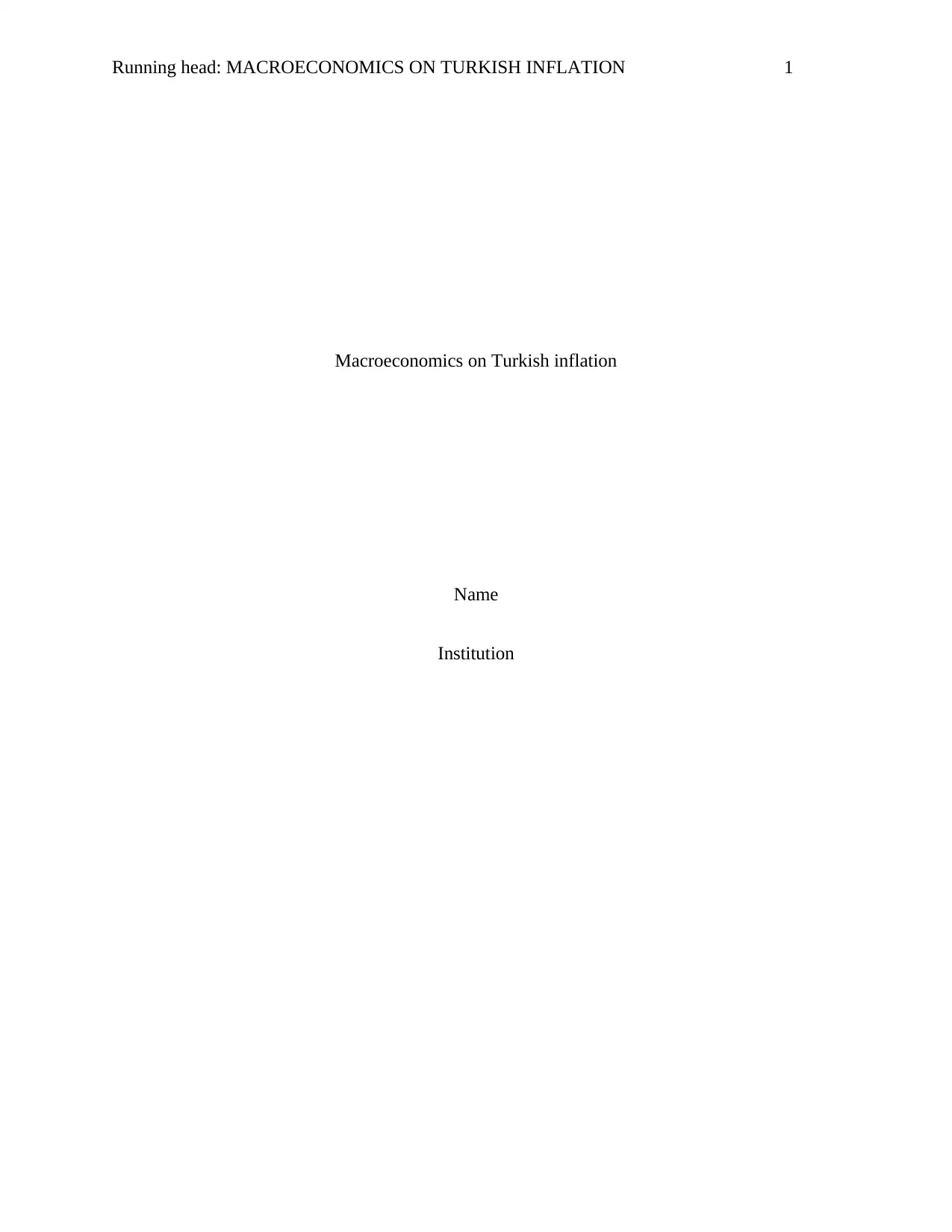
Running head: MACROECONOMICS ON TURKISH INFLATION 1
Macroeconomics on Turkish inflation
Name
Institution
Macroeconomics on Turkish inflation
Name
Institution
Paraphrase This Document
Need a fresh take? Get an instant paraphrase of this document with our AI Paraphraser
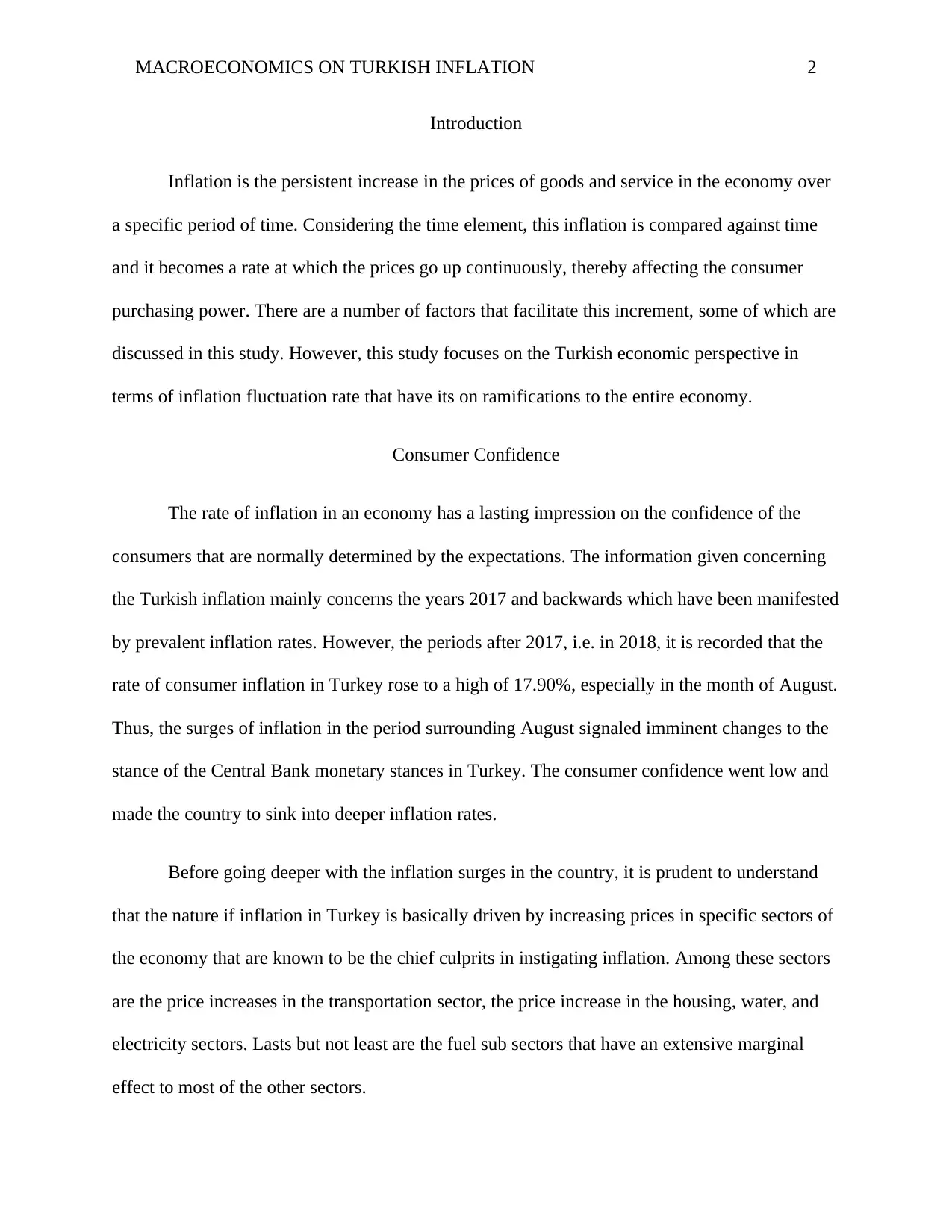
MACROECONOMICS ON TURKISH INFLATION 2
Introduction
Inflation is the persistent increase in the prices of goods and service in the economy over
a specific period of time. Considering the time element, this inflation is compared against time
and it becomes a rate at which the prices go up continuously, thereby affecting the consumer
purchasing power. There are a number of factors that facilitate this increment, some of which are
discussed in this study. However, this study focuses on the Turkish economic perspective in
terms of inflation fluctuation rate that have its on ramifications to the entire economy.
Consumer Confidence
The rate of inflation in an economy has a lasting impression on the confidence of the
consumers that are normally determined by the expectations. The information given concerning
the Turkish inflation mainly concerns the years 2017 and backwards which have been manifested
by prevalent inflation rates. However, the periods after 2017, i.e. in 2018, it is recorded that the
rate of consumer inflation in Turkey rose to a high of 17.90%, especially in the month of August.
Thus, the surges of inflation in the period surrounding August signaled imminent changes to the
stance of the Central Bank monetary stances in Turkey. The consumer confidence went low and
made the country to sink into deeper inflation rates.
Before going deeper with the inflation surges in the country, it is prudent to understand
that the nature if inflation in Turkey is basically driven by increasing prices in specific sectors of
the economy that are known to be the chief culprits in instigating inflation. Among these sectors
are the price increases in the transportation sector, the price increase in the housing, water, and
electricity sectors. Lasts but not least are the fuel sub sectors that have an extensive marginal
effect to most of the other sectors.
Introduction
Inflation is the persistent increase in the prices of goods and service in the economy over
a specific period of time. Considering the time element, this inflation is compared against time
and it becomes a rate at which the prices go up continuously, thereby affecting the consumer
purchasing power. There are a number of factors that facilitate this increment, some of which are
discussed in this study. However, this study focuses on the Turkish economic perspective in
terms of inflation fluctuation rate that have its on ramifications to the entire economy.
Consumer Confidence
The rate of inflation in an economy has a lasting impression on the confidence of the
consumers that are normally determined by the expectations. The information given concerning
the Turkish inflation mainly concerns the years 2017 and backwards which have been manifested
by prevalent inflation rates. However, the periods after 2017, i.e. in 2018, it is recorded that the
rate of consumer inflation in Turkey rose to a high of 17.90%, especially in the month of August.
Thus, the surges of inflation in the period surrounding August signaled imminent changes to the
stance of the Central Bank monetary stances in Turkey. The consumer confidence went low and
made the country to sink into deeper inflation rates.
Before going deeper with the inflation surges in the country, it is prudent to understand
that the nature if inflation in Turkey is basically driven by increasing prices in specific sectors of
the economy that are known to be the chief culprits in instigating inflation. Among these sectors
are the price increases in the transportation sector, the price increase in the housing, water, and
electricity sectors. Lasts but not least are the fuel sub sectors that have an extensive marginal
effect to most of the other sectors.
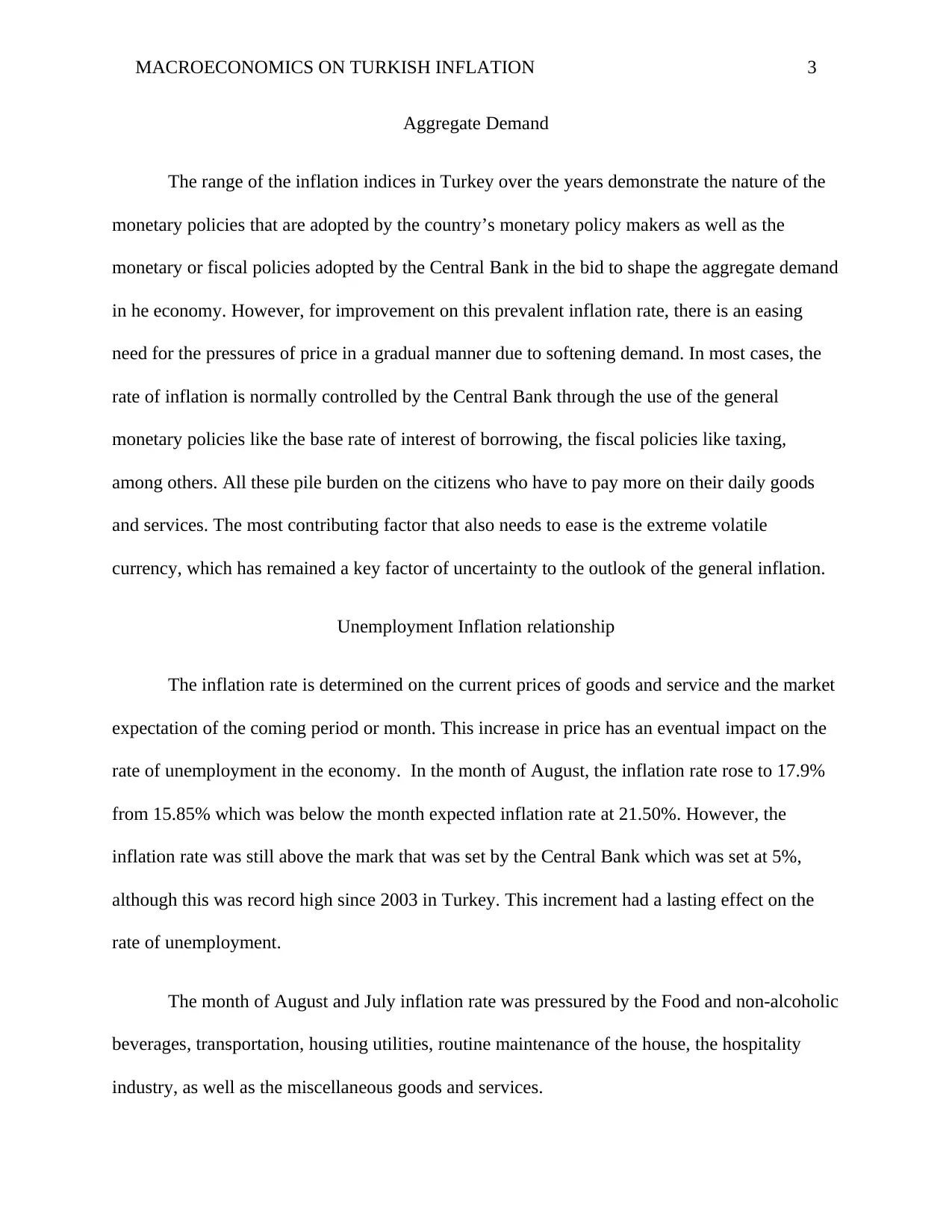
MACROECONOMICS ON TURKISH INFLATION 3
Aggregate Demand
The range of the inflation indices in Turkey over the years demonstrate the nature of the
monetary policies that are adopted by the country’s monetary policy makers as well as the
monetary or fiscal policies adopted by the Central Bank in the bid to shape the aggregate demand
in he economy. However, for improvement on this prevalent inflation rate, there is an easing
need for the pressures of price in a gradual manner due to softening demand. In most cases, the
rate of inflation is normally controlled by the Central Bank through the use of the general
monetary policies like the base rate of interest of borrowing, the fiscal policies like taxing,
among others. All these pile burden on the citizens who have to pay more on their daily goods
and services. The most contributing factor that also needs to ease is the extreme volatile
currency, which has remained a key factor of uncertainty to the outlook of the general inflation.
Unemployment Inflation relationship
The inflation rate is determined on the current prices of goods and service and the market
expectation of the coming period or month. This increase in price has an eventual impact on the
rate of unemployment in the economy. In the month of August, the inflation rate rose to 17.9%
from 15.85% which was below the month expected inflation rate at 21.50%. However, the
inflation rate was still above the mark that was set by the Central Bank which was set at 5%,
although this was record high since 2003 in Turkey. This increment had a lasting effect on the
rate of unemployment.
The month of August and July inflation rate was pressured by the Food and non-alcoholic
beverages, transportation, housing utilities, routine maintenance of the house, the hospitality
industry, as well as the miscellaneous goods and services.
Aggregate Demand
The range of the inflation indices in Turkey over the years demonstrate the nature of the
monetary policies that are adopted by the country’s monetary policy makers as well as the
monetary or fiscal policies adopted by the Central Bank in the bid to shape the aggregate demand
in he economy. However, for improvement on this prevalent inflation rate, there is an easing
need for the pressures of price in a gradual manner due to softening demand. In most cases, the
rate of inflation is normally controlled by the Central Bank through the use of the general
monetary policies like the base rate of interest of borrowing, the fiscal policies like taxing,
among others. All these pile burden on the citizens who have to pay more on their daily goods
and services. The most contributing factor that also needs to ease is the extreme volatile
currency, which has remained a key factor of uncertainty to the outlook of the general inflation.
Unemployment Inflation relationship
The inflation rate is determined on the current prices of goods and service and the market
expectation of the coming period or month. This increase in price has an eventual impact on the
rate of unemployment in the economy. In the month of August, the inflation rate rose to 17.9%
from 15.85% which was below the month expected inflation rate at 21.50%. However, the
inflation rate was still above the mark that was set by the Central Bank which was set at 5%,
although this was record high since 2003 in Turkey. This increment had a lasting effect on the
rate of unemployment.
The month of August and July inflation rate was pressured by the Food and non-alcoholic
beverages, transportation, housing utilities, routine maintenance of the house, the hospitality
industry, as well as the miscellaneous goods and services.
⊘ This is a preview!⊘
Do you want full access?
Subscribe today to unlock all pages.

Trusted by 1+ million students worldwide
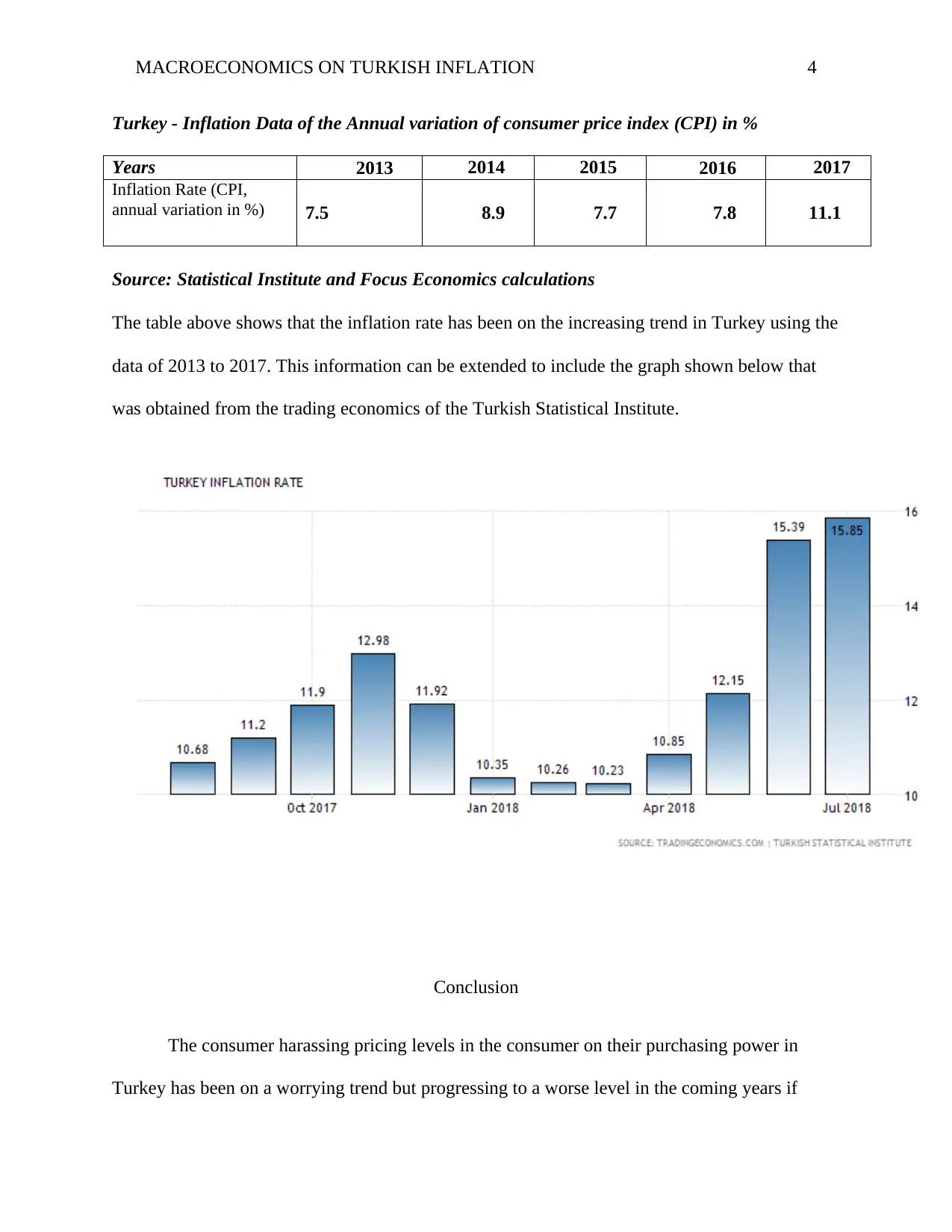
MACROECONOMICS ON TURKISH INFLATION 4
Turkey - Inflation Data of the Annual variation of consumer price index (CPI) in %
Years 2013 2014 2015 2016 2017
Inflation Rate (CPI,
annual variation in %) 7.5 8.9 7.7 7.8 11.1
Source: Statistical Institute and Focus Economics calculations
The table above shows that the inflation rate has been on the increasing trend in Turkey using the
data of 2013 to 2017. This information can be extended to include the graph shown below that
was obtained from the trading economics of the Turkish Statistical Institute.
Conclusion
The consumer harassing pricing levels in the consumer on their purchasing power in
Turkey has been on a worrying trend but progressing to a worse level in the coming years if
Turkey - Inflation Data of the Annual variation of consumer price index (CPI) in %
Years 2013 2014 2015 2016 2017
Inflation Rate (CPI,
annual variation in %) 7.5 8.9 7.7 7.8 11.1
Source: Statistical Institute and Focus Economics calculations
The table above shows that the inflation rate has been on the increasing trend in Turkey using the
data of 2013 to 2017. This information can be extended to include the graph shown below that
was obtained from the trading economics of the Turkish Statistical Institute.
Conclusion
The consumer harassing pricing levels in the consumer on their purchasing power in
Turkey has been on a worrying trend but progressing to a worse level in the coming years if
Paraphrase This Document
Need a fresh take? Get an instant paraphrase of this document with our AI Paraphraser
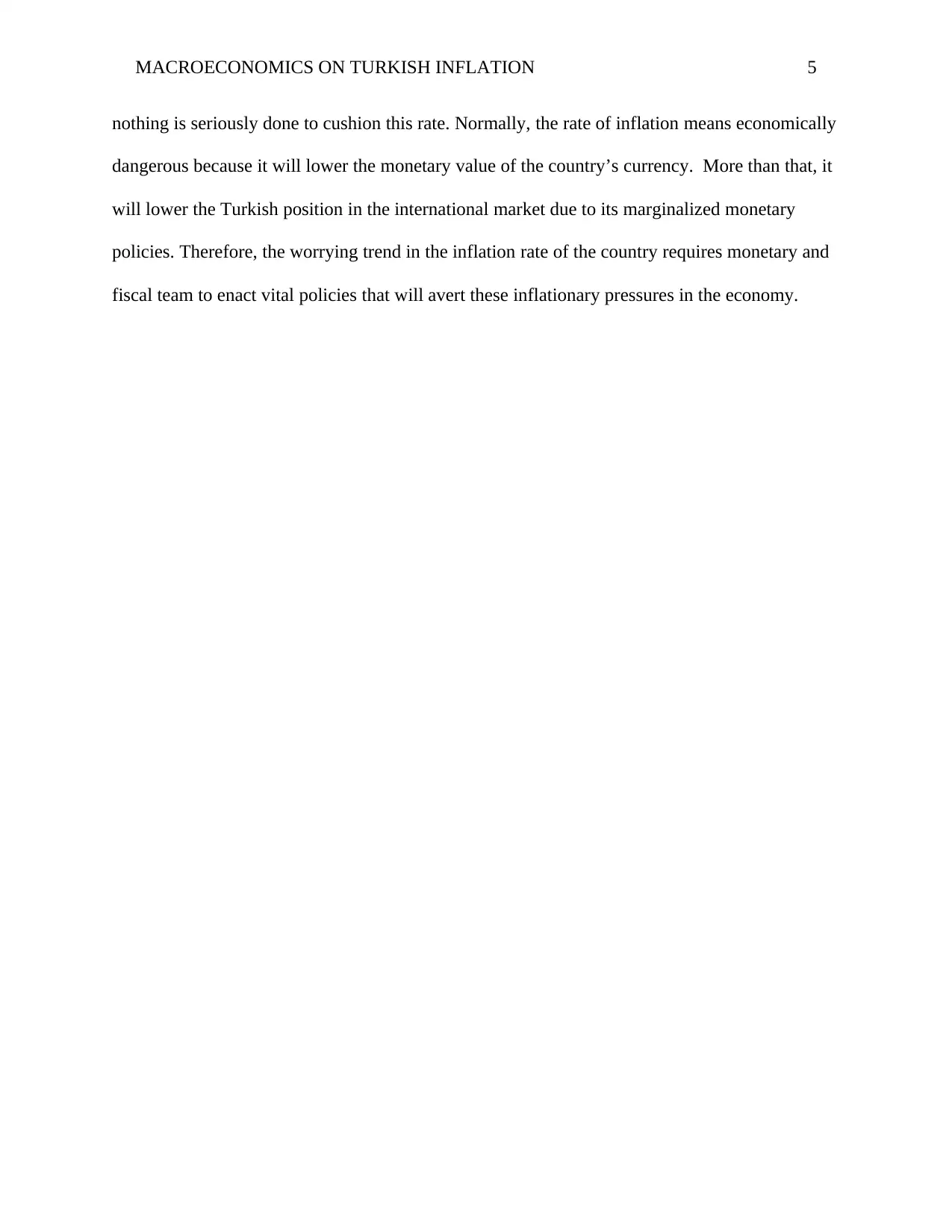
MACROECONOMICS ON TURKISH INFLATION 5
nothing is seriously done to cushion this rate. Normally, the rate of inflation means economically
dangerous because it will lower the monetary value of the country’s currency. More than that, it
will lower the Turkish position in the international market due to its marginalized monetary
policies. Therefore, the worrying trend in the inflation rate of the country requires monetary and
fiscal team to enact vital policies that will avert these inflationary pressures in the economy.
nothing is seriously done to cushion this rate. Normally, the rate of inflation means economically
dangerous because it will lower the monetary value of the country’s currency. More than that, it
will lower the Turkish position in the international market due to its marginalized monetary
policies. Therefore, the worrying trend in the inflation rate of the country requires monetary and
fiscal team to enact vital policies that will avert these inflationary pressures in the economy.
1 out of 5
Related Documents
Your All-in-One AI-Powered Toolkit for Academic Success.
+13062052269
info@desklib.com
Available 24*7 on WhatsApp / Email
![[object Object]](/_next/static/media/star-bottom.7253800d.svg)
Unlock your academic potential
Copyright © 2020–2025 A2Z Services. All Rights Reserved. Developed and managed by ZUCOL.





